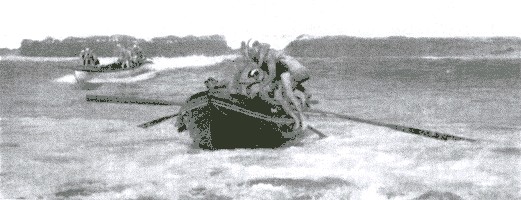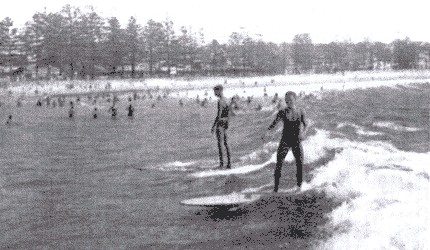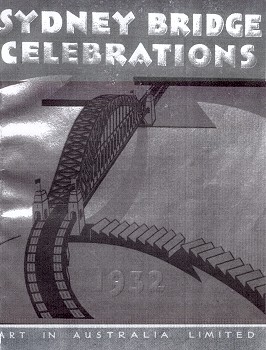 |
surfresearch.com.au
paterson : surf beaches, 1932 |
| home | catalogue | history | references | appendix |
|
He was a member
of the North Styene Bathers Club and said to have imported a surfboard
from Hawaii, circa 1908-1912.
However, note that
despite the inclusion of the photograph of Jack King and another surfboard
rider at Manly (Photo #3 below), Paterson makes no mention of surfboard
riding in his article, prefering an account of "the thrilling surf life
boat races."
A more interesting
and informative article probably written by Paterson (the author is identified
only by initials) in 1908.
See Source Documents:
C.D.P. : Sun-Baking,
Surf-Bathing, and Camp Life in NSW.
Extract from The
Red Funnel, Dunedin, New Zealand.Volume VI, Number 3, April 1908, pages
268 to 271.
Also see exerpts from Paterson's President's
Report of his world tour of surf beaches in 1924:
Surf Life Saving Association of
Australia : Annual Report.
Extracts from: SLSA
of Australia: Annual Report and Balance Sheet 1924-1925.
The Manly Daily Print, 18 Sydney Road,
Manly.
AUSTRALlA has
approximately 12,000 miles of coast line, and practically the whole of
it is a great chain of beautiful golden sandy beaches, ideal for surf bathing.
Where else will
you find such profusion?
Individual beaches
in other Countries are made much of, but where is another Country so prolific
in this respect with all their beauties and advantages?
One is apt to
be over-whelmed with the abundance of them.
Even if we have
not told the World as others have, their wonderful attractiveness is forcing
itself to its notice.
They are by virtue
of their own value becoming better and better known to those ever on the
lookout for Ssomethmg new, somethlng worth while.
Australians themselves
have long ago realised their worth, and avail themselves of their advantages
to the full.
Favoured with
glorious sunshine throughout the year, the conditions are such that surf
bathing is now the greatest national pastime of our people.
And look what
it is doing for them!
It has opened
up a field of pleasure for all ages and both sexes.
It is free to
everyone.
The combined
effetct of salt water, fresh air, and golden sunshine on our clean sandy
beaches, is accounting for the general improvement (of it race already
unusually robust), in the healty stamina, physique, grace and beauty of
our youth.
It ha has largely
contributed to the record which we hold as the healthiest Country in the
world.
In a recent speech
His Royal Highness the Prince of Wales declared that he strongly believes
the future of British trade and industry would depend on the peoples' fitness
and vigor.
If Australia's
future prosperity is to depend similarly, we have little cause for fear.
Where else, even
now, will you find such magnificent, well developed, upstanding vigorous
specimens of the human race as may be seen on our beaches?
In the metropolitan
area of Sydney alone we have upwards of 20 distinct beaches, available
to the million and a quarter in-habitants of our city, and visitors.
Just imagine
it for a moment- over 20 perfect bathing beaches, within the Sydney Metropolitan
area. Other cities consider themselves fortunate if they have one.
Hundreds of thousands
of Sydney inhabitants use these beaches every day, and so it is throughout
the whole of our picturesque coastline.
It is calculated
that the average attendance on the beaches of N. S. W . on a Summer Saturday,
Sunday or Holiday, is not less than a quarter of a million.
As the direct
out-come of the popularity of surf bathing, has arisen what is probably
the most unusual voluntary organisation in the World.
The Surf Life
Saving Association of Australia.
A humanitarian
organisation ...
Page 43
... with the sporting
instinct strongly developed.
There is little
or no danger to the surf bather provided ordinary care is exercised, but
as the crowds of bathers increased, so did the risk.
Many ventured
too far out to sea and had difficulty in getting balck.
A severe back
wash, or perhaps the sweep in one of the many channels which form, would
take bathers off their feet, and poor swimmers were soon in trouble.
This had to be
stopped if the popularity and safety of surfing was to be maintained.
Starting in the
early years of the present cenutry, gradually Clubs were created on each
beach, composed of athletic young men, possessed of more than the unusual
swlmmlng ability (in a nation where a knowledge of swimming is common to
almost all) and filled witll the desire to help their fellow batherr in
distress.
Qllite voluntarily,
and at no little personal expense, they undertook the work of guarding
the bathers in their leisure hours.
These Clubs,
which now exist throughout the Commonwealth, embracing a membership of
about 6,000, are all banded into one great controlling oganisation - The
Surf Life Saving Association of Australia, than which no finer body of
young men could be found, living and working up to their motto of "Vigilance
and Service" and all voluntarily.
Australia and
the World will never realise the high debt we owe these youths.
In the past 20
years the recorded rescues by the Club Members were over 20,000.
Many go unrecorded.
It is not that
our beaches are dangerous, but the great spread of the enormous crowd of
bathers on any popular beach, often forces individuals into channels which
otherwise would be avoided.
These channels
change from day to day according to the prevailing wind and are also effected
by the tide.
What may be perfectly
safe in the morning is dangerous to a weak swimmer in the afternoon.
The Head Centre
of the Surf Life Savers is naturally Sydney, but centres and branches with
their groups of Clubs operate throughout Australia.
This Association
has published a handbook which serves as the world's textbook on surf or
open water life saving.
Its teachings,
as well as the special gear adopted as a result of many years of experience,
have been followed in many countries in the old and new world.
All active Members
of Clubs are required to undergo strenuous training and exami-
Page 46
... on before
being allowed t take up the voluntary duty of patrol work on the beaches.
The Club members
meet regularly in interclub competition.
These take the
form of Surf Carnivals" held almost weekly on the beaches in Summer.
These usually
prove most impressive as well as exciting.
Often 1,000 competitors
participate.
The programme
opens with a parade of 2O picked men, from each CIub participating, with
banners flying and life saving gear complete.
The brightly
coloured distintive marching costumes, the gay banners, the the magnificent
specimens of vigorous youth, sturdy and bronzed, carrying themselves like
well disiplined soldiers, proud of their membership and record, under azure
blue skies, and in perfect sunshine, constitute a spectacle of virile manhood
of which any Country can be proud, and which one cannot witness without
a thrill.
The programme
which follows embraces strenuous surf and rescue races, as well as a variety
of beach athletic events, but the crowds wait for, and watch with bated
breath, the thrilling surf life boat races.
These brest the
largest waves on the outward journey, often standing on their end in the
attempt, while on the return to the beach, after rounding the buoys a quarter
of a mile at sea, they shoot with the speed of a rocket on the crest of
the shoreward racing waves, in a whirl of fan like spray.
Capzises are
frequent, but they only add to the excitement, but the skill attained by
sturdy sweepmen, like Vikings of old, saves many a boat crew from a hasty
ducking, if not more serious injury.
Australia owes
much to these Clubs, but the health and vigor of young Australians it typified
by its youth on the beaches, and this health and stamina, which is daily
being built up, will be reflected in the vigour with which Australians
all will face the burdens of life now, and in the years to come.
Page 47
 |
Exciting finish
to
Photograph
by
|
 |
Sydney lads have gained much proficiency as Surf Board Riders. Photograph
by
Later printed in
|
 |
Sydney Bridge Celebrations Art in Australia Limited,1932. (Arthur McQuitty, McQuitty House, Regent Street, Sydney, for Art in Australia Ltd., 24 Bond Street, Sydney.) Paterson, C. D.: Our Glorious Surf
Beaches.
|

| home | catalogue | history | references | appendix |